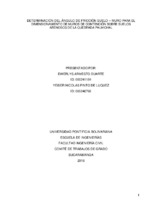| dc.contributor.advisor | Bautista García, Gerardo | |
| dc.contributor.author | Armesto Duarte, Dwerlys | |
| dc.contributor.author | Pinto De Luquez, Yeiser Nicolas | |
| dc.coverage.temporal | 2018 | |
| dc.date.accessioned | 2020-06-19T14:20:12Z | |
| dc.date.available | 2020-06-19T14:20:12Z | |
| dc.date.issued | 2018 | |
| dc.identifier.uri | http://hdl.handle.net/20.500.11912/5623 | |
| dc.description | 114 páginas | spa |
| dc.description.abstract | El presente trabajo de grado se realizó con el fin de determinar el ángulo de ficción entre la base de un muro de contención en concreto reforzado y el suelo de fundación arenoso. Este ángulo tradicionalmente se ha calculado como un porcentaje del ángulo de fricción interna (normalmente entre el 5096 y el 1378). El material escogido corresponde a una arena mal gradada proveniente de la quebrada Palmichal. Inicialmente se realizaron ensayos tales como granulometría, compactación y corte directo para obtener las propiedades físicas necesarias para dimensionar un muro de contención a escala. Una vez clasificado el suelo y obtenidas sus propiedades mecánicas, se procedió a dimensionar y diseñar el muro de contención estable al volteo. de tal forma que este fallara por deslizamiento. El muro fue construido en concreto reforzado en el laboratorio de estructuras de la Universidad Pontificia Bolivariana Seccional Bucaramanga y sobre él se aplicaron fuerzas horizontales con la ayuda de un muro de reacción y un actuador mecánico. Durante las pruebas con dicho actuador, se generó una memoria de datos de las fuerzas horizontales que producían el deslizamiento. Finalmente se determinó el ángulo de fricción suelo-muro para el material estudiado, se analizaron los resultados y se elaboraron una serie de recomendaciones para trabajos similares posteriores. | spa |
| dc.description.abstract | The present work was carried out in order to determine the angle of friction between the base of a retaining wall in reinforced concrete and the sandy foundation soil. This angle has traditionally been calculated as a percentage of the internal friction angle (usually between 50% and 67%). The material chosen corresponds to a badly graded sand from the Palmichal stream. Initially, tests were performed such as granulometry, compaction and direct cutting to obtain the physical properties necessary to size a retaining wall to scale. Once the soil was classified and its mechanical properties were obtained. we proceeded to size and design the retaining wall stable to the tipping. in such a way that it failed due to landslide. The wall was built in reinforced concrete at the structure's laboratory of the Universidad Pontificia Bolivariana Sectional Bucaramanga and horizontal forces were applied to it with the help of a reaction wall and a mechanical actuator. During the tests with said actuator, a data memory was generated of the horizontal forces that produced the sliding. Finally the ground-wall friction angle for the studied material was determined. the results were analyzed and a series of recommendations for similar later work were elaborated_ | eng |
| dc.format.mimetype | application/pdf | |
| dc.language.iso | spa | |
| dc.publisher | Universidad Pontificia Bolivariana | spa |
| dc.rights | Attribution-NonCommercial-NoDerivatives 4.0 International | * |
| dc.rights.uri | http://creativecommons.org/licenses/by-nc-nd/4.0/ | * |
| dc.title | Determinación del ángulo de fricción suelo – muro para el dimensionamiento de muros de contención sobre suelos arenosos de la quebrada Palmichal | spa |
| dc.type | Trabajo de grado | spa |
| dc.publisher.department | Escuela de Ingenierías | spa |
| dc.publisher.program | Ingeniería Civil | spa |
| dc.type.hasVersion | publishedVersion | spa |
| dc.description.sectional | Bucaramanga | spa |
| dc.description.degreename | Ingeniero Civil | spa |


